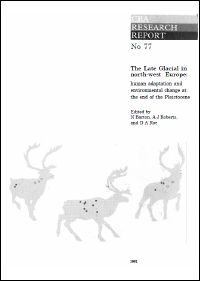CBA Research Reports
Council for British Archaeology, 2000. (updated 2020) https://doi.org/10.5284/1000332. How to cite using this DOI
Data copyright © Council for British Archaeology unless otherwise stated
This work is licensed under the ADS Terms of Use and Access.
Primary contact
Council for British Archaeology
92 Micklegate
York
YO1 6JX
UK
Tel: 01904 671417
Resource identifiers
- ADS Collection: 281
- DOI:https://doi.org/10.5284/1000332
- How to cite using this DOI
The Late Glacial in north-west Europe: human adaptation and environmental change at the end of the Pleistocene
N Barton, A J Roberts and D A Roe (editors)
CBA Research Report No 77 (1991)
ISBN 1 872414 15 X
Abstract

It is well known that major climatic shifts have taken place throughout human history and that they elicited numerous, rapid and sometimes irreversible environmental responses which profoundly influenced the organisms living in those environments. The Late Glacial period of 14,000-10,000 years ago is a case of special significance, for which the evidence survives in generally good condition. It is a period of pronounced climatic upheaval and instability, being distinguished by a series of short-lived warming and cooling episodes, marking the end of the last Ice Age and the transition to the present Postglacial epoch. Although the Late Glacial in north-west Europe has been widely studied by independent specialists in the different fields of the natural sciences and archaeology, rather less attention has been given to integrating these abundant and diverse lines of evidence under a common unifying theme. This volume of papers therefore seeks to redress the balance by combining the many varied specialist interests in the Late Pleistocene while, at the same time, focusing specifically on the relationship between human adaptive behaviour and environmental stress during this period of pronounced climatic change.
Contents
- Title pages
- Contents (pp v-vi)
- List of figures (pp vi-viii)
- List of tables (p ix)
- List of contributors (pp ix-x)
- Preface (p xi-xii)
- Part 1 : Palaeoecology and environmental change at the end of the Pleistocene
- Palaeoenvironmental developments during the Late Glacial of the Weichselian by Else Kolsrup (pp 1-6)
- Climatic change in Scotland during the Devensian Late Glacial: the palynological record by Richard Tipping (pp 7-21)
- Dendrochronology and radiocarbon calibration of the early Holocene by Bernd Becker and Bernd Kromer (pp 22-24)
- AMS dates from the Late Glacial and early Postglacial in north-west Europe: a review by Rupert A Housley (pp 25-39)
- Palaeoecology of the Late Glacial and early Postglacial of Belgium and neighbouring areas by Jean-Marie Cordy (pp 40-47)
- A Late Glacial Interstadial mammal fauna from Gough's Cave, Somerset, England by Andrew P Currant (pp 48-50)
- Late Glacial mammoths in Britain by Adrian M Lister (pp 51-62)
- Part 2 : Classic Late Glacial hunting economies: regional variations and subsistence strategies
- Subsistence strategies and economy in the Mabdalenian of the Paris Basin, France by Fraçoise Audouze and James Enloe (pp 63-71)
- Some new thoughts on old data on humans and reindeer in the Ahrensburgian Tunnel Valley in Schleswig-Holstein, Germany by Klaus Bokelmann (pp 72-81)
- The Late Upper Palaeolithic site of Schweskau, Ldkr Lüchow-Dannenberg (Germany) and some comments on the relationship between the Magdalenian and Hamburgian by Klaus Breest and Stephan Veil (pp 82-99)
- Pioneers in deglaciated landscapes: the expansion and adaptation of Late Paleolithic societies in southern Scandinavia by Anders Fischer (pp 100-121)
- The Late Palaeolithic in southern Sweden: investigations in a marginal region by Lars Larsson (pp 122-127)
- The Creswellian, Creswell and Cheddar by Roger Jacobi (pp 128-140)
- Late Glacial archaeological residues from Wales: a selection by Andrew David (pp 141-159)
- Preliminary report on marked human bones from the 1986-1987 excavations at Gough's Cave, Somerset, England by Jill Cook (pp 160-168)
- Nutritional constraints and Late Glacial adaptive transformations: the importance of non-protein energy sources by John D Speth (pp 169-178)
- Ethnographic models for Late Glacial hunter-gatherers by Lawrence H Keeley (pp 179-192)
- Part 3 : The Pleistocene/Holocene transition: human adaptations and chronological studies
- A study of hunting lesions containing flint fragments on reindeer bones at Stellmoor, Schleswig-Holstein, Germany by Bodil Bratlund (pp 193-207)
- Late Upper Palaeolithic and Mesolithic chronology: points of interest from recent research by Christopher Smith and Clive Bonsall (pp 208-212)
- New observations on the Late Upper Palaeolithic site of Belloy-sur-Somme (Somme, France) by Jean-Pierre Fagnart (pp 213-227)
- The early Postglacial occupation of the southern part of the North Sea Basin by André Gob (pp 227-234)
- Technological innovation and continuity at the end of the Pleistocene in Britain by Nicholas Barton (pp 234-245)
- A Late Glacial and early Postglacial site at Three Ways Wharf, Uxbridge, England: interim report by John Lewis (pp 246-255)
- Bedburg-Königshoven: A Pre-Boreal Mesolithic site in the Lower Rhineland (Germany) by Martin Street (pp 256-270)
- Index (pp 271-279)
Download report
| The Late Glacial in north-west Europe: human adaptation and environmental change at the end of the Pleistocene (CBA Research Report 77) | 25 Mb |







